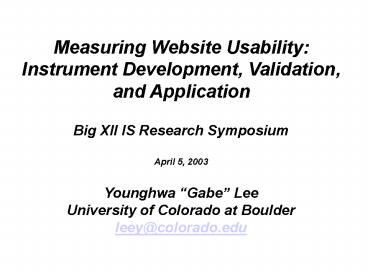Measuring Website Usability: Instrument Development, Validation, and Application - PowerPoint PPT Presentation
1 / 20
Title:
Measuring Website Usability: Instrument Development, Validation, and Application
Description:
Title: PowerPoint Presentation Author: leey Last modified by: Don A. Lucca Created Date: 9/4/2002 4:14:32 PM Document presentation format: On-screen Show – PowerPoint PPT presentation
Number of Views:140
Avg rating:3.0/5.0
Title: Measuring Website Usability: Instrument Development, Validation, and Application
1
Measuring Website Usability Instrument
Development, Validation, and Application
Big XII IS Research Symposium April 5,
2003 Younghwa Gabe Lee University of Colorado
at Boulder leey_at_colorado.edu
2
Agenda
- Background
- Previous Studies
- Research Objective
- Research Design
- Expected Contribution
- Discussion
3
Background
- Online business failures are increasing as
customers turn away from unusable or unfriendly
sites. Build it and they will come mentality
has led to the demise of e-commerce sites when
sites are too late, too buggy, or too complex - - Becker and Mottay, 2001
- In a poorly designed EC environment, users might
be uncomfortable with the uncertainty and
ambiguity caused by lack of interaction with
websites. - Jahng et al, 2000
- The number of shoppers and total sales are still
marginal, mainly because of poor interfaces - - Jarvenpaa and Todd, 1997
4
Background
- Building a usable website is important since
website is the - only source for online customers to touch, feel,
search, - communicate, and experience the products or
services - available at the online store
- Usable websites
- Build positive attitude (Singh and Dalal, 1999)
- Increase stickiness (Rettie, 2001)
- Increase revisit rates (Klein, 1998)
- Increase online purchase (Palmer, 2002)
- Increase performance (Nielsen, 2000)
- Provide more satisfaction (Lund, 1999)
5
Website Usability Research
Website Usability
How to measure?
How to verify?
Instruments Development
Design and Testing
- HCI
- Company-specific
- Industry Gurus
- Few IS researchers
- HCI
- MIS SIG HCI
6
Previous Studies
- Measurement problems of website usability
- No consensus on the definition and dimensions of
website usability - A number of single-item constructs
- Intuition and experience-based Few efforts to
develop measurement using scientific methods - HCI-oriented objective variables (error rate and
download time) - No Investigation of the relationship between
website usability constructs - No process model
7
- Agarwal and
- Venkatesh (2002)
- Content
- Ease of Use
- Promotion
- Made-for-the-medium
- Emotion
- Palmer (2002)
- Download Delay
- Navigability
- Information Content
- Interactivity
- Responsiveness
- Kim et al. (2002)
- Firmness
- Convenience
- Delight
- Zhang and
- von Dran (2002)
- Content
- Enjoyment
- Privacy
- User empowerment
- Visual appearance
- Technical Support
- Navigation
- Credibility
- Organization
- McKinney et al.
- (2002)
- Access
- Usability
- Entertainment
- Hyperlinks
- Navigation
- Interactivity
8
Download Delay
Navigability
Information Content
Perceived Success
Interactivity
Responsiveness
Palmer (2002)
9
Motivation of the Study
- Current inconsistency and incompleteness among
website usability measurement is the crucial
problem of website usability studies. - There is very little in the way of concrete
measurement that tells us how good a website
really is. Current guidelines, methods, and
metrics do help to design better websites, but
there is room for improvement - - Tarasewich (2000)
10
Research Objective
- Develop measurement of website usability
- 18 constructs and 62 instruments have been
identified - Investigate the causal relationship between
website usability constructs - Revealed Causal Mapping approach (Nelson et al.,
2000) - Examine the effects of website usability
constructs to multiple dependent variables - Satisfaction, purchase intention, revisit
intention, actual purchase, affect, and loyalty - Investigate generalizability of the new
measurement and identify different causal maps
under different boundary conditions - Gender, Product, Industry and Culture
11
Research Design
- Instruments Development
- Literature review
- Interviews with web usability experts
- SUN, IBM, 37 Signals.com website designers
- A Focus Group Study (IS-majored master-level
subjects) - A Major survey to 400 Business undergraduate
students - Exploratory Factor Analysis
- Causal Relationship Between Website Usability
Constructs - Interviewed with experts (n 20)
- Interviewed with experienced online customers (n
40) - Data Analysis suggested by Nelson et al. (2000)
12
Research Design
- Effects of Website Usability Factors to Diverse
Dependent Variables - The effects of Price, Time, Scarcity,
Convenience, Fun, Usefulness will be examined
together - CFA and Path Analysis will perform
- Data Analysis LISREL
- Boundary Conditions
- Compare websites with different gender-focused
- Compare websites with different types of products
(Hedonic vs Utilitarian) - Compare websites with different cultures (U.S. vs
Japan) - Compare websites with different stakeholders
(Customers, Designers, and Managers) - Data Analysis PLS
13
Website Usability Constructs
14
Causal Relationship between Website Usability
Constructs
15
Effects of Usability Constructs to Diverse
Dependent Variables
Actual Purchase
Revisit Intention
Satisfaction
Purchase Intention
Affect
Loyalty
Price Time Scarcity Convenience Fun Usefulness
16
Expected Contribution
- Develop new measurement of website usability
- provide a better means to evaluate website design
quality - Identify causal relationship between website
usability constructs - Provide a deeper understanding of how online
customers build their usability perception - Examine effects of website design factors to
diverse dependent variables - justify the investment on website usability
- Investigate measurements generalizability and
causal maps under different boundary conditions - help to perform future study using the
measurement - help designers to allocate limited resources to
the most important usability factors
17
Discussion
18
Discussion
19
Revealed Causal Mapping Repertory
Grid
Causal Relationship Identification
Construct Identification Guided Interviews
Open Interviews No
requirement for multiple elements Multiple
elements are required Identify constructs and
causal Identify constructs using
Relationship based on repeated
Triadic Methods to identify Interviews for
identifying Mid-theory exists
No requirement for mid-theory
20
Discussion
- Alternative ways of conducting the research
- Process Model (e.g TAM) vs Multiple Dependent
Variables - Boundary conditions valuable to be observed































